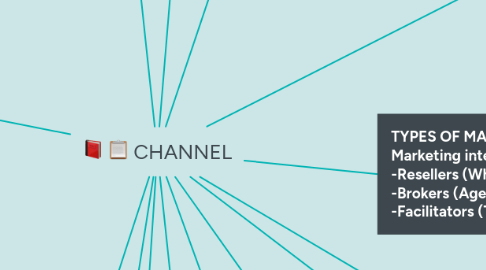
1. MAJOR CHANNEL STRATEGY DECISIONS
1.1. Selection of marketing channel
1.1.1. Market factors
1.1.2. Product factors
1.1.3. Organizational factors
1.1.4. Competitive factors
1.2. Distribution Intensity
1.2.1. Intensive
1.2.2. Selective
1.2.3. Exclusive
1.3. Legal Problems of Exclusive Distribution
1.3.1. Exclusive dealing agreement
1.3.2. Closed sales territories
1.3.3. Tying agreements
1.4. Who Should Perform Channel Functions?
1.4.1. A member of the channel
1.4.2. Responsibilities of the different members
2. CONCEPTS OF CHANNEL MANAGEMENT, CONCFLICT AND COOPERATION
2.1. Channel Management and Leadership CHANNEL CAPTAIN - Dominant and controlling member of a marketing channel
2.1.1. Horizontal conflict
2.1.2. Vertical conflict
2.1.3. The gray market
2.2. Achieving Channel Cooperation
2.2.1. Best achieved when all members of channel see themselves as equal components of the same organization
2.2.2. Channel captain should provide this leadership
3. LOGISTICS AND SUPPLY CHAIN MANAGEMENT
3.1. Effective logistics requires
3.1.1. Proper supply chain management
3.1.2. Control of the activities of purchasing, processing, and delivery
3.2. Supply chain - Complete sequence of suppliers and activities that contribute to the creation and delivery of merchandise
3.2.1. Begins with raw-material inputs for production
3.2.2. Ends with the movement of final product to customers
3.2.3. Takes place in two directions: upstream and downstream
3.3. Radio Frequency Identification (RFID) -Technology that uses a tiny chip with identification information that can be read by a scanner using radio waves from a distance
3.4. Enterprise Resource Planning (ERP) -Software system that consolidates data from among a firm’s various business units
3.5. Logistical Cost Control -The distribution function accounts for half of a firm’s total marketing costs
3.5.1. Third-party logistics firms - Specialize in handling logistical activity
4. Freight Forwarders and Supplemental Carriers
4.1. Act as transportation intermediaries
5. Warehousing
5.1. Storage warehouse
5.2. Distribution warehouse
6. THE ROLE OF MARKETING CHANNELS
6.1. Facilitating the exchange process
6.2. Sorting
6.3. Standardizing exchange transactions
6.4. Facilitating searches by both buyers and sellers
7. TYPES OF MARKETING CHANNELS - Marketing intermediary -Resellers (Wholesaler and Retailers ) -Brokers (Agents) -Facilitators (Transportation companies)
7.1. Direct selling
7.1.1. Direct channel - Carries goods directly from a producer to the business purchaser or ultimate user
7.1.2. Direct selling - Strategy designed to establish direct sales contact between producer and final user
7.2. selling through intermediaries
7.2.1. Producer to wholesaler to retailer to consumer
7.2.2. Producer to agent to wholesaler to retailer to consumer
7.2.3. Producer to agent to business user
7.2.4. Producer to wholesaler to business user Industrial distributor
7.2.5. Producer to agent to wholesaler to business user
7.3. Dual distribution
7.3.1. more than one channel
7.4. Reverse channels
7.4.1. return goods to their producers
8. VERTICAL MARKETING SYSTEMS Planned channel system designed to improve distribution efficiency and cost-effectiveness by integrating various functions throughout the distribution chain
8.1. Forward integration - Firm attempts to control downstream distribution
8.2. Backward integration - Manufacturer attempts to gain greater control over inputs to production process
8.3. Corporate and Administered SystemsCorporate and Administered Systems
8.3.1. Corporate marketing system
8.3.2. Administered marketing system
8.4. CONSTRACTUAL SYSTEMS Coordinates channel activities through formal agreements among channel members
8.4.1. Wholesalet-Sponsored Voluntary Chain
8.4.2. Retail cooperative
8.4.3. Franchise
9. MAJOR COMPONENTS OF A PHYSICAL DISTRIBUTION SYSTEM
9.1. PHYSICAL DISTRIBUTION
9.1.1. Customer service
9.1.2. Transportation
9.1.3. Inventory control
9.1.4. Protective packaging and materials handling
9.1.5. Order processing
9.1.6. Warehousing
9.2. The Problem of Suboptimization
9.2.1. Results when the managers of individual physical distribution functions attempt to minimize costs
9.3. Customer-Service Standards
9.3.1. State the goals and define acceptable performance
10. TRANSPORTATION
10.1. Classes of Carriers
10.1.1. Common carriers - Provide transportation services as for-hire carriers to the general public
10.1.2. Contract carriers - For-hire transporters that do not offer their services to the general public
10.1.3. Private carriers - Provide transportation services solely for internally generated freight
10.2. Major Transportation Modes
10.2.1. RAILROADS
10.2.2. MOTOR CARRIERS
10.2.3. WATER CARRIERS
10.2.4. PIPELINES
10.2.5. AIR FREIGHT
11. Intermodal Coordination
11.1. Piggyback
11.2. Birdyback service
11.3. Fishyback service
12. Inventory Control Systems
12.1. RFID technology
12.2. Just-in-time (JIT)
12.3. Vendor-managed inventory (VMI)
13. Order Processing
13.1. Conducting a credit check
13.2. Keeping a record of the sale
13.3. Making appropriate accounting entries
13.4. Locating orders, shipping them, and adjusting inventory records
14. Protective Packaging and Materials Handling
14.1. Materials handling system - Activities for moving products within plants, warehouses, and transportation terminals
14.1.1. Unitizing
14.1.2. Containerization

